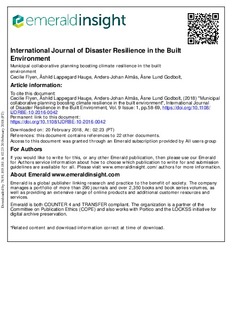| dc.contributor.author | Flyen, Cecilie | |
| dc.contributor.author | Hauge, Åshild Lappegard | |
| dc.contributor.author | Almås, Anders-Johan | |
| dc.contributor.author | Godbolt, Åsne Lund | |
| dc.date.accessioned | 2018-02-22T07:57:23Z | |
| dc.date.available | 2018-02-22T07:57:23Z | |
| dc.date.created | 2016-09-12T14:55:31Z | |
| dc.date.issued | 2018 | |
| dc.identifier.issn | 1759-5908 | |
| dc.identifier.uri | http://hdl.handle.net/11250/2486298 | |
| dc.description.abstract | Purpose – A meta-study covering the past decade maps the development of Norwegian municipal planning, climate adaptation and institutional vulnerability towards climate change. This paper aims to explore the implementation of climate adaptive changes in Norwegian legal planning and building framework into municipal practice and policy instruments from 2007 to 2016. The study is planned to answer the question: what drivers ensure increased municipal efforts in their climate adaptive planning and building practice?
Design/methodology/approach – The paper presents empirical findings from two qualitative research projects, each with nine interviews of municipal key personnel within three municipalities’ planning and building services and an ongoing qualitative, expert interview-based study (eight individual/group interviews).
Findings – Risk reduction and climate resilience are still unsatisfactorily attended in many Norwegian municipalities. There is a gap between political and administrative levels in communicating bilateral expectations and needs for incorporation of climate adaptive measures. Policy instruments maintaining climate adaptation are in demand by different building process actors. Yet, extreme weather events seem to be the main drivers for actual implementation of climate change aspects into municipal policy instruments. Networking, both within and between municipalities, is an important strategy for learning climate adaptation. | nb_NO |
| dc.language.iso | eng | nb_NO |
| dc.publisher | Emerald | nb_NO |
| dc.rights | Navngivelse 4.0 Internasjonal | * |
| dc.rights.uri | http://creativecommons.org/licenses/by/4.0/deed.no | * |
| dc.title | Municipal collaborative planning boosting climate resilience in the built environment | nb_NO |
| dc.type | Journal article | nb_NO |
| dc.type | Peer reviewed | nb_NO |
| dc.description.version | publishedVersion | nb_NO |
| dc.source.volume | 9 | nb_NO |
| dc.source.journal | International Journal of Disaster Resilience in the Built Environment | nb_NO |
| dc.source.issue | 1 | nb_NO |
| dc.identifier.doi | 10.1108/IJDRBE-10-2016-0042 | |
| dc.identifier.cristin | 1380452 | |
| dc.relation.project | Norges forskningsråd: 237859 | nb_NO |
| dc.description.localcode | © Cecilie Flyen, Åshild Lappegard Hauge, Anders-Johan Almås and Åsne Lund Godbolt. 2018 Published by Emerald Publishing Limited Published in International Journal of Disaster Resilience in the Built Environment. Published by Emerald Publishing Limited. This article is published under the Creative Commons Attribution (CC BY 4.0) licence. | nb_NO |
| cristin.unitcode | 194,61,0,0 | |
| cristin.unitname | Fakultet for arkitektur og design | |
| cristin.ispublished | true | |
| cristin.fulltext | original | |
| cristin.qualitycode | 1 | |

